#THEXDER
Text
Go play EGGCONSOLE
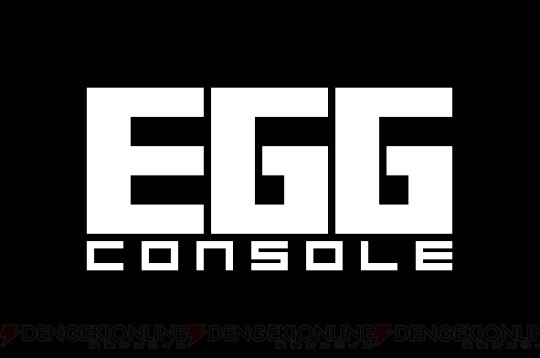
The Switch has basically turned into a game historian's dream come true, with classic titles getting ported, remade, remastered and localized for the first time all over the place. From Hamster's weekly Arcade Archives, to M2's fantastic as always work with Sega Ages, and Nintendo's own library available via their online service, there's no shortage of great titles for anyone who wants to revisit their own childhood, or just dive deep to better understand the past.
What I definitely didn't expect was for classic Japanese computer games to start ending up on the console, much less in North America. For a long time, these games have kinda had a forbidden fruit appeal for Westerners, a last frontier of games that was difficult to navigate due to the language barrier, the aging hardware, Windows cannibalizing all other operating systems during the 90's and of course, few of the games being exported over here, but it's gotten a lot better in recent years, mostly thanks to D4 enterprises.
They started with Project EGG, ostensibly Japan's equivalent of GOG, and after a few other ventures on various platforms, they've decided to port their most classic titles to Switch under the label of EGGCONSOLE, including, as I mentioned earlier, on the Western eShop. This seems odd at first, but considering the vintage of these games, they don't have that much Japanese text to parse, and often using joysticks and controllers back in the day, rather than keyboards, meaning they transfer to typical console controllers rather easily (you can still use an emulated keyboard in-game, if you wish).

As you can imagine, not all of the games have aged super gracefully; the action titles are straightforward enough, but the adventure games or RPG's with more complex systems and labyrinth-like levels are a bit too incomprehensible, though the releases have a lot of effort put into them to make sure you can see what they're all about, from level selects, to savestates to rewinds.

The three titles I've definitely put the most time into are Thexder, Silpheed, and Relics. Relics is definitely the most stymieing of the three, but it's so cool I keep trying to slog through it; it's got a body stealing mechanic which is always great, and a cool biomechanical aesthetic way ahead of its time.

But the two titles that are the easiest to get into are sort of a duology that compliment each other, as they're both by Game Arts and insanely impressive on a technical level; Thexder and Silpheed.
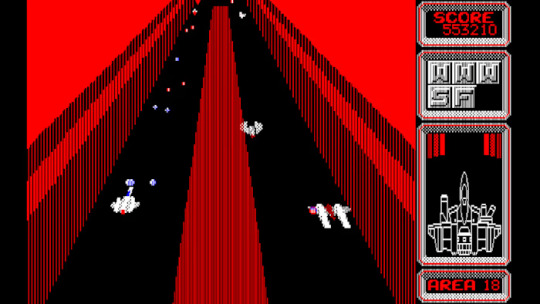
Silpheed is insane. I was aware of the Sega CD release before, but I didn't realize it was a sorta-sequel, sorta-remake of the computer original, and that it was basically Star Fox running on an 8-bit computer. I dunno how they got wireframes and polygons like this on the PC-88, but it's insane. The actual gameplay is pretty good, nothing compared to other shmups of the era and especially now, but the level design is pretty good and the weapon loadout select is pretty great, and adds a strategic wrinkle.
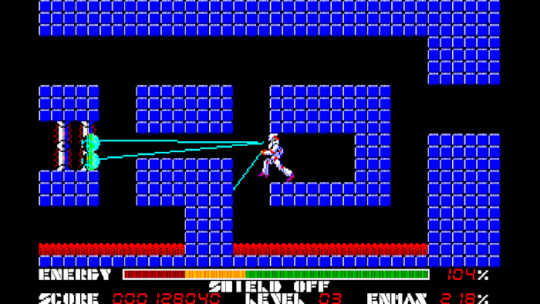
Thexder is a sidescrolling mecha-action title, and again, the technical prowess on display really steals the show. The animation on the robot as he lethargically strides forward, then turns into a plane blasting enemies down with an Itano Circus-type laser really makes the whole experience and feels really satisfying, even if the enemy layouts are a little too insane, at times. It's also nice to have a perfectly emulated version on a console since the Famicom version, developed by pre-Final Fantasy Square, was a bit of a disaster, and the PS3 remake (which included the original) is probably gonna be delisted soon.
It really does fill me with a glee that these titles are so much more easily playable now; you can really see how some of them shaped and molded more accessible contemporaries (such as the streamlined RPG's on the Famicom) while having their own identity that would never really be replicated. I'm super excited to see what other titles they rerelease down the line, though I'd really like to see titles from other platforms, like the PC-98, MSX or X68000. Looking at the upcoming titles, they seem to be sticking to PC-88 for now, but there's always hope for the future. For how much we (kinda rightfully) complain about game companies not doing enough to preserve the past, you gotta pay due respect to the few that are, to serve as a blueprint of what we need more of.
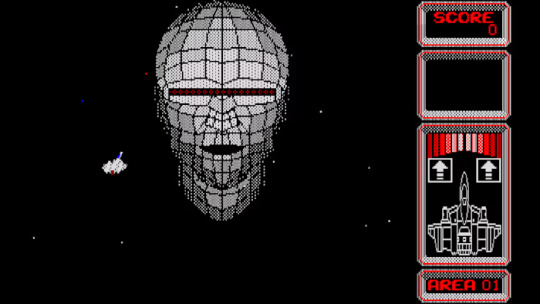
0 notes
Photo

#Fire Hawk Thexder The Second Contact#1989#末弥 純#Jun Suemi#Fire Hawk#art#print ad#video game ad#retro gaming#video games#80s#1980s#design#scifi#mecha#mech#run and gun#shooter#shmup
51 notes
·
View notes
Text

Wibarm
Wibarm is the lovechild of Game Arts’ Thexder and Falcom’s Xanadu, two of the most popular games in the mid-1980s Japanese PC scene. Much as in Thexder, you control a transforming robot that can change between mecha and jet forms, as well as using an auto-targeting laser as a primary weapon. But rather than offering a straightforward arcade-like experience, it grafts on some RPG elements, many taken straight from Xanadu.
Read more...
#Hardcore Gaming 101#Kurt Kalata#review#Wibarm#8 bit#action rpg#rpg#role playing games#Broderbund#FM 7#IBM PC#Japanese PC#mecha#PC88#PC98#JRPG#Japanese RPG#Sharp X1#shooter#retro games#video games
12 notes
·
View notes
Text


Thexder and Blanche are of the same breed of robot and I love them both a lot
0 notes
Text

Brother I spent sooo much money today
We had a big day today. Me and my partner have had basically no money between both of us for the past two weeks, and then we both got paid yesterday so we made a big ass trip to the asian market and bought like a months worth of food. I ended up missing band again as a result because we had to make some other unexpected stops but we have sooo much food I cant believe it. I got matcha ramune I'm probably gonna try tomorrow
I played a little bit of Fairune Blast before and after our outing because I'm like doing science to figure out how to get more points, and I got myself to 19th on the world leaderboard as Hope Girl!!!!!!!!! Im top 20!! I really gotta find the secrets with Yamato because I get the theory behind Uzume's gameplay, her special move basically kills all enemies and collects their points and powerups all at the same time, but I dont get Yamato. This is the tradeoff for her being the best character in Kamiko and Uzume being like uplayable
I also forgot in the rush of the day but I got the Viz Manga subscription so I can read more Inuyasha now. Just a little bit ago I bought Thexder and the Jajamaru lost RPG collection too. Thexder was the last EGG Console game I didnt have and Jajamaru looked cool and was $3. I have so much enrichment in my enclosure now. And one of my favorite bigger tumblr users followed me back too!! Damn what a big day
Heres a pic my partner grabbed for me

Peace and Long Life
1 note
·
View note
Text
0 notes
Photo

USA 1996
#USA1996#SIERRA#COKTEL VISION#DYNAMIX#SYNERGISTIC SOFTWARE#ACTION#PINBALL#ADVENTURE#IBM#MACINTOSH#THEXDER#3D ULTRA PINBALL#THE LAST DYNASTY
5 notes
·
View notes
Photo

Night Arcade by Sparkwarrgon ©
#Bally Midway#Rampage#Capcom#Marvel vs. Capcom#Game Arts#Thexder#graphic design#illustration#arcade#video games#retro gaming#Sparkwarrgon ©
7 notes
·
View notes
Photo

7 notes
·
View notes
Photo
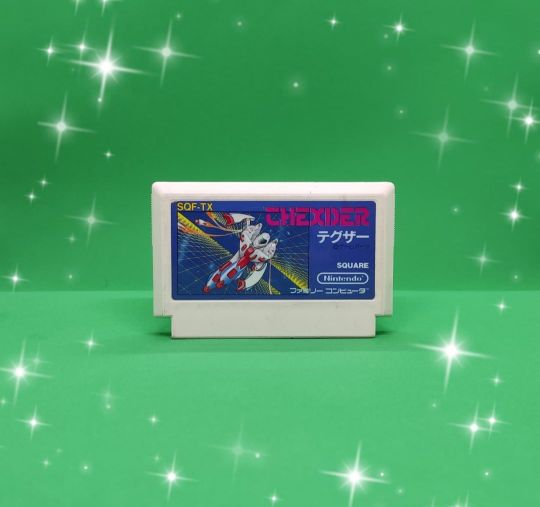
Thexder, a platform shooter from Japan, is the first game edited by Squaresoft for the Famicom. You pilot a Battletech-style robot capable of switching from a mech into a jet at any time. You've got to manage carefully your weapon's energy and your shield if you want to survive. Thexder est un "platform shooter" japonais, c'est le premier jeu édité par Squaresoft pour la Famicom. Vous y pilotez un robot à la Battletech qui peut alterner les formes robot/jet à volonté. Vous devez gérer avec attention l'énergie de votre armé et de votre bouclier si vous voulez survivre. #nintendo #nintendones #nintendonesgames #nesgames #famicom #nintendofamicom #famicomgames #nintendofamicomgames #retrocommunity #retrogamemafia #retrogames #retrogamingcommunity #retrogaming #classicgaming #vintagegaming #squaresoft #thexder (à 4ème Arrondissement Marseille, Marseille) https://www.instagram.com/gamersdugrenier/p/CXUQs77ofnB/?utm_medium=tumblr
#nintendo#nintendones#nintendonesgames#nesgames#famicom#nintendofamicom#famicomgames#nintendofamicomgames#retrocommunity#retrogamemafia#retrogames#retrogamingcommunity#retrogaming#classicgaming#vintagegaming#squaresoft#thexder
0 notes
Photo

Is the protagonist of Thexder genderless? Who knows. Make a game about robots and you’ll avoid falling into the trap of ill-advised representation, perhaps.
Also, I had to go to StrategyWiki just to find out if it was “Bellmetal” or “Bellmeta” because his overlapping fist threw me off. Thanks, cover artists. (SW says it’s “Bellmeta”.)
0 notes
Photo
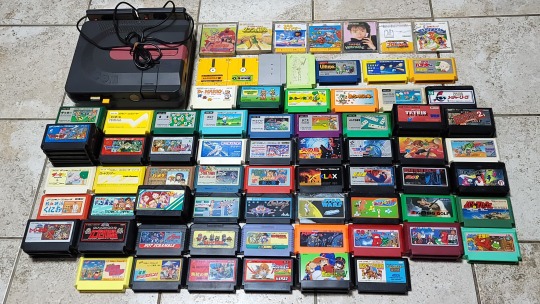








Sharp Twin Famicom console system (AN-500B) [JPN] - Sharp / Nintendo
9x Nintendo Famicom Disk System games
85x Nintendo Famicom game cartridges
FDS... Kinnikuman, Legend of Zelda 2, Moero TwinBee, SD Gundam World: Gachapon Senshi Scramble Wars, Idol Hotline: Nakayama Miho no Tokimeki High School, Pro Wrestling, Exciting Baseball, Super Mario Bros 2, Mahjong Kazoku.
Carts... ???, ???, Ultima: Kyoufu no Exodus, Lunar Ball, Mezase Pachi Pro, Dr. Mario, Mario Open Golf, Yoshi’s Egg, Yoshi’s Cookie, Balloon Fight, Major League, Soccer, Pinball, Mah-Jong, Golf, Devil World, Tennis, 4-nin Uchi Mahjong, Tetris, Tetris 2 + BomBliss, Dragon Quest II, Dragon Quest III, Dragon Quest IV, Thexder, Transformers: Convoy no Nazo, Hino Tori, Top Gun, Yie Ar Kung-Fu, Booby Kids, Pooyan, Lode Runner, Ninja Hattori-kun, Star Force, Shin Jinrui, Klax, Hokuto no Ken (Fist of the North Star), Hokuto no Ken 2, Legend of Kage, Nekketsu Kouha Kunio-kun, Nekketsu Koukou Dodgeball-bu, LaSalle Ishii no Childs Quest, Family Circuit, Galaga, Star Wars (Namco), Family Jockey, Fighting Golf, Paris-Dakar Rally Special, SD Hero Soukessen – Taose! Aku no Gundan, SD Gundam – Gachapon Senshi 2 – Capsule Senki, Mobile Suit Z Gundam: Hot Scramble, Kamen Rider Club, Dragon Ball: Shenron no Nazo, Formation Z, Ninja-kun: Majou no Bouken, Ninja Jajamaru-kun, Jajamaru no Daibouken, Tokoro-san no Mamoru mo Semeru mo, Dengeki Big Bang!, Hiryuu no Ken: Ougi no Sho, Zombie Hunter, Ganbare Pennant Race, Derby Stallion.
#famicom#famicom disk system#nintendo#NES#video games#cartridge#vintage#8bit#japanese#sharp#console#video game#acquisitions
52 notes
·
View notes
Text
Serious Play, Sincere Review - Target 11: Paving the Way for Japanese games on western PCs
Originally written in Japanese by Akira Yamashita for the July 1989 issue of Micom BASIC Magazine
Currently Japanese video games are highly regarded around the world. If you go to a video arcade in the United States, 9 out of every 10 cabinet will contain a so-called "overseas version" of a video game originally developed in Japan. Moreover, the Nintendo Entertainment System (or NES) has been conquering the nation for over a year. Famicom games that were already popular in Japan have been gradually ported over to the NES and achieved great success in the States as well. It seems the word "Nintendo" has entered the vernacular of American children as a word that represents a form of entertainment. By contrast, Japanese developed PC games haven't been making much of a splash overseas in the same way that their arcade and NES counterparts have done. But lately they are suddenly starting to get attention, as many ports are now being released. This month we tried shining a spotlight on these Japanese games that paving the ways on the foreign market.
Japanese Games From Sierra
Sierra On-Line is headquartered on the west coast of the United States, in a small town located on the outskirts of California. With around 200 employees, Sierra is among the top five software houses in the United States, with their titles always dominating the top ten best-selling charts.
If you've been playing adventure games for a while now, perhaps you might had heard of the name Sierra at least once. They were the great company that made the original versions of several adventure games, such as Mystery House and Wizard & The Princess, that were released in Japan by Starcraft. It is well-known that these games, which were part of the so-called "Hi-Res Adventure" series, were the first adventure games to feature graphical screens and were very popular even in the States.
Their latest line of games, the King's Quest series, have also attracted a lot of attention, becoming a big hit with over a million units sold. They're adventure games that are a bit different from the rest, in which the player types in a command on the keyboard and the on-screen character will act accordingly.
For example, in the fourth entry of the series, The Perils of Rosella, if you type the command "clean room" after the heroine has entered an unclean room, it will trigger an event in which she will fix each of the beds, takes a broom out of the shelf and starts sweeping the floor, gathers all the dishes scattered on the kitchen table and then washes them on the sink. The animation is quite detailed too.
What sets this apart from a usual Japanese game is that such a scene in the game exists not necessarily to have the player progress through the story, but simply to entertain. The King's Quest games employ a score system in which the amount of points a player has increases for each event that they managed to do. However, the game can still be completed, even if the player's score is low. This means that there's no pushy obligation for the player to watch all the scenes in the game, which is good. The more you play, the more discoveries you make that makes the game's world feel deeper. Sierra On-Line calls this kind of game a "3-D Animated Adventure Game."
When we learned that such a company that has been leading the computer game software industry in both, the past and present, has been porting and publishing Game Arts titles in the United States under their own brand, we immediately went to the company's Japanese subsidiary, Sierra On-Line Japan. to get to the story.
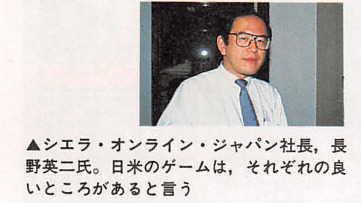
"When it comes to Japanese arcade games, particularly in the action genre, our staff recognize their tremendous quality and how much they have evolved. Our staff, starting with our company's president, would repeatedly visit Japan to research our country's games and study their market, and it was during one of such visits that they encountered a game titled Thexder running on the NEC PC-8801 Mk. II SR. They felt in love on first sight and immediately went to Game Arts to negotiate for the license and that's how we ended up introducing the game to the IBM PC." says Eiji Nagano, President of Sierra On-Line Japan.
Two of Games Arts' titles have already been converted and published by Sierra On-Line. Both titles have been selling relatively well, with Thexder, released on August 1988, moving 200,000 units, while Silpheed, released on April 1989, has moved 35,000 units a month after its release.
I was curious about the quality of these ports, so I tried them out on the spot and I was surprised at how good they turned out.
Starting with Thexder, the explosion patterns were not included due to hardware limitations and the music is now rendered in beeps, but other than that, I found almost no difference with the original PC-8801 version. I've been told there are many hardcore Thexder players in the United States, with some mighty players having even achieved a score of 10 million points.
As for Silpheed, there is no doubt that it holds up quite well compared to its PC-8801 counterpart. Aside from the fact that it's a bit slower, its MIDI-generated soundtrack is, in a single word, amazing. I played the game using a Roland MT-32 sound module and I was deeply moved by the breadth of its sound. Perhaps there aren't that many people experienced with the MIDI music format, but if you play this game, you will certainly be captivated by it. It seriously made me wish that more Japanese game developers would support the MIDI format.
I went on asking Mr. Nagano how they managed to put out such faithful conversions with high-degree of accuracy.
"The conversions of both of these titles were handled by American programmers. Immediately after the contract was signed, a programmer would be sent to Game Arts to stay for around a week and they would be given technical guidance with detailed instructions. Since there isn't that much of a difference between Japanese and American programmers in terms of technical skills to begin with, it's simply a matter of mastering the proper know-how quickly. Perhaps the most difficult part is the fact that the comments on the source code are written in Japanese. But even I, as someone who was involved with the conversion process, was surprised at what they achieved."
It appears that Sierra On-Line plans on converting more Japanese titles to western machines at a pace of two titles a year. Their conversion of Sorcerian, which is currently under development, is scheduled to be released this December.
In contrast, Sierra On-Line Japan is also planning on releasing several of its own original games to Japanese PCs. Just the thought of being able to play a King's Quest game on the NEC PC-9801 is enough to make me excited.
However, the accuracy of the conversion could be an issue. Everyone knows that factors such as disk access and screen loading times are great factors in affecting a player's motivation. Since the original versions are great games, I hope that any conversion could be just as good as the Silpheed port.
Mr. Nagano has this to say on the matter.
"When it comes to porting software between Japan and the United States, there must be adjustments made to suit each country's climate and characteristics. For example, it must be said that getting a Japanese person to comprehend dry American humor can be quite a difficult task. Knowing how to adapt that is the key."
To become a software exchange base between the United States and Japan. Sierra On-Line Japan has become an interesting place.
Report of Japanese Games in the United States Part 1
John Williams, a representative of Sierra On-Line, writes
"Japanese video games are quite popular in the United States thanks to their unique atmosphere. But if I'll be frank, when it comes to [Japanese] PC game publishers, it must be said that they're struggling quite a bit.
For example, when it comes to the U.S. market, I think the Japanese company with the biggest share is Taito, but they don't quite stack up to Nintendo, even if they seem to be doing well porting their own arcade titles.
Koei is also praised by magazines for their historical simulation games, but they aren't available in many formats, so they're unlikely to have a hit at this point.
When you keep that in mind, our company's Thexder is a Japanese-developed PC game that did quite well. I'm sure Silpheed will also become a hit like Thexder. However, I don't think it will be a tremendous hit due to the current overwhelming popularity of Nintendo in the United States.
But we'll do our best. Silpheed will be the proof that the Nintendo is not necessarily the perfect game machine. It's a splendid game. I'm sure everyone will appreciate the MIDI compatibility as well."
Japanese Games From Kyodai
Kyodai Software Marketing, with its unusual name, was founded last spring as a joint venture between Broderbund Software and 11 Japanese PC software houses. Their offices are located in San Rafael, California, which is north of San Francisco. I can't helped but be surprised by their first lineup, which includes Ys, Murder Club, Hydlide III and Curse of Babylon, because it's quite extravagant.
The following is the full list of companies participating in Kyodai
Broderbund
Hummingbird
T&E Soft
Pony Canyon
Kogado Studios
Xtalsoft
Game Arts
Telenet Japan
Nihon Falcom
BPS
Micro Cabin
Riverhill Soft
Mr. Tsumura, the President of Kyodai, explained to us the reason for the company's formation via an international phone call.
"When it comes to games that were ported over from the United States to Japan, there aren't that many that ended up becoming hits. However, when you look at the arcade and Nintendo markets, in other words, Japanese games that were converted to the United States, it's been a great success. Therefore we turned our attention towards Japanese PC games, which have yet to reach the U.S. market in any significant way. Within that background we couldn't overlook the matching needs between the Japanese software houses who were seeking business opportunities in the foreign market, and Broderbund Software, who wanted to handle Japanese software with their own distribution channel."
The selection process on which games to port over was started immediately after Kyodai was established. Naturally the criteria of choosing a game was based on what suits the American market, but the way they handled it is quite interesting.
"We started by creating three evaluation teams comprised of Americans. They're very different from each other, with one team being comprised of business people, the second of high school and college students who are enthusiasts, and the third one of people who don't know much. We then have them play a game on a Japanese computer, whether it's a PC-8801, PC-9801 or an MSX, and gauge their reactions. Naturally we have an interpreter on their side to help them out. For our current lineup, we picked games that were popular with all three teams."
Unfortunately I was unable to look at any screenshots of the ports themselves, but the company aims on releasing all four titles within the year and are developing them at a rapid pace. I asked Mr. [Tokihiro] Naito from T&E Soft, who have apparently seen a sample version of the Hydlide III port, on his thoughts on it.
"The resolution of the [western] machine is half of the Japanese PC, so it was a bit painful to some extent, but they still did a pretty good job. The arrangements that gave me a sense of the American programmer's sensibilities were quite interesting. For example, the trees on the plain were moving in a noisily matter and the hero's weapon could be fired rapidly with somewhere up to 6 to 9 shots on-screen (as opposed to the 3 shots on the original version). As the programmer for the original version, I'm hoping that the port doesn't completely loses the sense of the game."
During my conversation with Mr. Naito, I could get a glance of the difference in the national characteristics of a Japanese player and an American player. When pondering on what makes a game a hit in Japan and in the United States, it's a factor that can't be ignored. American players are likely to think about a puzzle for months, no matter how absurd it might be, while Japanese players will likely drop a game if they get stuck even if it was only for a bit. On the other hand, Americans like games where they mindlessly shoot things, while the Japanese like games such as the Tower of Druaga, in which knowledge is important.
In the end, can a Japanese PC game overcome such difference in national characteristics and truly become an international hit. Mr. Tsumura calmly analyzed that in the following matter.
"Americans as a race are, by their very nature, rich when it comes to their imagination. They have the ability to enter a game's world and immerse themselves into a role without much explanation needed. Therefore, most American games, if I have to say, are rather simple in terms of graphics and we're created to stimulate the imagination of the player. In contrast, Japanese games are neatly designed from the start, with good graphics and a good story. When it comes to Americans, I don't see any reason why they would dislike such a game. If we can built a brand image that says 'this is what Japanese PC games are like', then we would have more than sufficient capability to create hits."
Mr. Tsumura continued explaining his aspirations for Kyodai.
"Ultimately I want Japanese software houses to start producing games for the American market from the get-go and release them under the Kyodai brand. For that purpose we intend to gradually provide information about the American market to Japanese developers. To everyone in Japan, if you have anything you want to learn, contact us without hesitation We will keep working like we were representatives of Japan, so please support us."
Kyodai's Release Lineup
Murder Club (by Riverhill Soft) - The first installment in the J.B. Harold series. A detective-themed adventure that uses a menu-driven system, it was praised for its beautiful graphics. There were perhaps many people who were moved by the amazing visuals of the recently-released Sharp X68000 version. Can the U.S. port achieve the same quality of graphics? And will they also include the investigative journal?
The Ancient Land of Ys (by Nihon Falcom) - An active RPG with a user-friendly design that allows any mystery to be simplified enough to be solved by anyone. We're particularly curious if the United States could be receptive of this kind of game.
Hydlide III (by T&E Soft) - An active RPG that implements features such as a notion of time and a carrying limit. The objective of the game is to defeat the dark ruler Gaizack in order to bring back peace to Fairyland. Since the original version already included an English language mode, a conversion should be simple.
Curse of Babylon (by XTALSOFT) - A somewhat unsual active RPG played from a side-view perspective, but uses a bum-rush system. The game's option to freely choose your background music was much talked about. It was also known for its very large map. Taking a look at this, it seems that most of the games being ported are Active RPGs.
Report on Japanese Games in the United States Part 2
Akira Hibiki, Micom BASIC Magazine's U.S. correspondent, writes:
"When it comes to arcade games, the Pac-Man series, along with Final Lap and Operation Thunderbolt are all popular in the video arcades around my area. Tetris also seems to be popular here, but it's a version of the game developed by Atari [as opposed to the Sega version that was released in Japan]. Surprisingly Gradius doesn't seem to be very popular here. Seeing a black person credit-feeding his way through Splatterhouse until getting to the end made me smile.
As for the NES, Japanese games are overwhelmingly popular. The Legend of Zelda and The Adventure of Link are always selling out in stores, so they're pretty hard games to obtain. However, most kids don't seem to be aware of their Japanese origins. With that said, a game magazine here ranked Zaxxon No.1 in popularity. I suspect there must have some secret way to enjoy that game.
As for Japanese-developed PC games, unfortunately they don't seem to be that well-known, if at all."
In Conclusion
When thinking about it, there has been many things that Japanese PC games had learned from American games. The most obvious example being the RPG genre. Many types of RPGs have been born by using the systems of two great series, Ultima and Wizardry, as a foundation and then adding several flavors of originality. And there's no mistake that this is a development that will continue in the future.
The debt that Japanese games have receive from the United States is truly immeasurable. But now that the environment has been set up to allow Japanese PC games to enter the market, perhaps it's time to return the favor. It's difficult to know whether a game that was a hit in Japan could also be a hit in the United States or not. Perhaps a game that didn't do well in Japan might capture the hearts of Americans. At any rate, if a Japanese-produced PC game can make an American game player or developer feel something, then I would be really glad as someone who participates in this industry.
Advancing into the foreign will be one of the big challenges that must be faced when it comes to Japanese-made PC games.
13 notes
·
View notes

